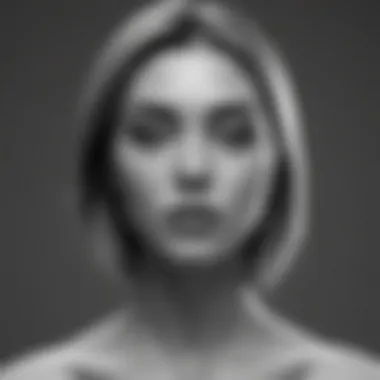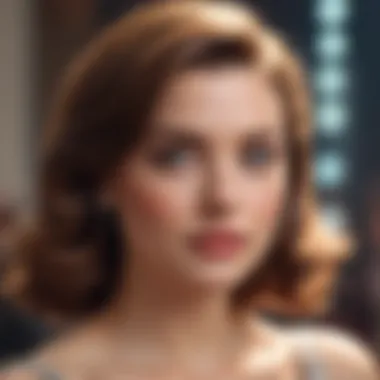Captivating Insights into Glamour Magazine Cover Evolution


Overview of Glamour Magazine Covers
Glamour magazine covers have been a prominent fixture in the fashion and beauty industry, serving as visual representations of trends, styles, and cultural influences. These iconic visuals not only showcase the evolution of design but also wield significant impact on pop culture.
Analysis and Critique
In dissecting Glamour magazine covers, one must evaluate the interplay of elements such as layout, typography, imagery, and celebrity representation. Comparisons to previous covers can illuminate shifts in styles and messaging, providing insight into the publication's editorial decisions.
EpisodeScene Breakdown
Delving into the detailed components of a Glamour magazine cover involves examining the visual composition, color schemes, cover lines, and the subtleties in model poses and expressions. Each element contributes to the overall narrative conveyed by the cover, influencing reader perceptions and reactions.
Audience Reception and Ratings
Audience responses to Glamour magazine covers vary widely, with some covers provoking controversy or acclaim. Tracking metrics like social media engagement, newsstand sales, and reader feedback offers a multifaceted view of how different covers resonate with diverse audiences.
Recommendations and Conclusion
For fashion enthusiasts, industry professionals, or individuals intrigued by the intersection of style and culture, Glamour magazine covers provide a visual feast ripe for exploration. By synthesizing the key points discussed in this analysis, readers can gain a deeper appreciation for the artistry and influence of Glamour's cover designs.
Introduction
In today's fast-paced world of fashion and beauty, magazine covers hold a unique significance. They serve as the initial point of contact between the publication and the reader, setting the tone for the content within. Cover designs play a crucial role in attracting attention, reflecting current trends, and establishing the publication's identity. The allure of Glamour magazine covers extends beyond mere visuals; they encapsulate the essence of style and sophistication that the brand embodies. This article embarks on a journey to dissect the nuances of these iconic covers, unraveling the trends, styles, and cultural impacts that have shaped the world of fashion and beauty.


Brief Overview of Glamour Magazine
Glamour magazine, a trailblazer in the realm of fashion publications, has a rich history dating back decades. Founded with the mission to celebrate women's empowerment, Glamour has been a pioneer in promoting diverse perspectives on beauty, fashion, and lifestyle. Over the years, the magazine has evolved to cater to the ever-changing tastes of its audience, staying relevant in an industry known for its fickleness. With a focus on inclusivity and authenticity, Glamour has carved a niche for itself in the competitive world of fashion magazines.
Importance of Magazine Covers
Magazine covers serve as visual narratives, communicating the essence of the publication's content in a single glance. For Glamour magazine, covers provide a snapshot of the latest trends in fashion and beauty, offering readers a glimpse into the world of luxury and style. These covers not only showcase renowned personalities but also encapsulate societal shifts and cultural movements. They have the power to spark conversations, set new standards, and redefine beauty norms. In a media-driven world, Glamour covers stand as symbols of creativity and influence, shaping the aspirational dreams of generations.
Evolution of Glamour Magazine Covers
The Evolution of Glamour Magazine Covers stands as a pivotal aspect within the realms of fashion and beauty journalism, encapsulating the metamorphosis of visual storytelling through the cover designs of Glamour magazine. Delving into the Evolution of Glamour Magazine Covers unveils a tapestry of shifting trends, innovative styles, and cultural influences that have shaped the very essence of the publication's identity. From the early pioneering designs to the contemporary digital-age aesthetics, this exploration captures the dynamic progression and impact of cover compositions over time.
Early Designs and Themes
The genesis of Glamour magazine covers saw a fusion of sophistication and minimalism, with emphasis placed on elegant typography and subtle imagery. Early designs often revolved around classic fashion motifs, showcasing timeless beauty through monochromatic palettes and refined details. Themes centered on sophistication, grace, and poise, setting a foundational tone for future cover iterations.
Shifts in Style and Aesthetics
As eras transitioned, Glamour covers experienced notable shifts in style and aesthetics, mirroring the evolving currents of fashion and beauty industries. The 1960s witnessed a revolution in cover design, with bold graphics, experimental layouts, and vibrant colors becoming prominent. The following decades embraced diverse styles, from romantic softness in the 70s to the power dressing aesthetics of the 80s, showcasing the adaptability and versatility of Glamour covers.
Influence of Technology on Cover Design
The advent of technology catalyzed a paradigm shift in Glamour cover design, ushering in a new era of digital creativity and visual storytelling. Digital manipulation, retouching techniques, and online platforms revolutionized the way covers were conceptualized and created. Interactive elements, augmented reality features, and multimedia collaborations reshaped the landscape of Glamour covers, merging traditional print aesthetics with modern technological advancements.


Iconic Glamour Covers Throughout the Decades
In this segment, we embark on a riveting journey through time, unraveling the significance and impact of the Iconic Glamour Covers Throughout the Decades within the overarching narrative of Glamour magazine cover evolution. These covers serve as more than just visual representations; they encapsulate the zeitgeist, reflecting societal values, fashion trends, and cultural nuances that defined each era.
The exploration of Iconic Glamour Covers Throughout the Decades holds tremendous value in understanding the evolution of fashion journalism, the empowerment of female figures in media, and the dynamics of visual storytelling. Each cover acts as a time capsule, preserving the essence of its era while fostering connections between past, present, and future fashion sensibilities. By dissecting these covers from different decades, we unravel a tapestry of style, innovation, and symbolism that continues to shape the landscape of fashion and beauty.
1950s and 1960s
Delving into the enchanting realm of Glamour magazine covers from the 1950s and 1960s unveils a transformative period marked by elegance, sophistication, and societal shifts. These covers exude a sense of glamour and aspiration, capturing the essence of post-war optimism and the rising influence of women in fashion and media. From radiant models donning iconic designer pieces to bold typography choices that heralded a new era of graphic design, the covers from this period reflect a delicate balance between tradition and innovation. The juxtaposition of classic beauty standards with emerging social movements offers a nuanced perspective on the evolving role of women in society and the fashion industry.
1970s and 1980s
As we transition into the dynamic era of the 1970s and 1980s, Glamour magazine covers undergo a metamorphosis, mirroring the changing attitudes towards beauty, diversity, and individuality. These covers embrace bold colors, eclectic fashion trends, and a celebration of body positivity that resonates with the burgeoning cultural shifts of the time. From featuring trailblazing models breaking barriers in the industry to showcasing avant-garde styling that challenges conventional norms, the covers of this period embody a spirit of rebellion and self-expression. The infusion of pop culture references and avant-garde aesthetics transforms each cover into a visual manifesto of empowerment and inclusivity.
1990s and 2000s
The exploration of Glamour magazine covers from the 1990s and 2000s unveils a fusion of nostalgia, innovation, and technological advancements that redefine the visual language of fashion media. These covers embrace a more minimalist approach, focusing on sleek typography, bold imagery, and celebrity culture that captivated global audiences. With the rise of digital media and celebrity influence, these covers served as a bridge between traditional print journalism and the digital age, sparking conversations on identity, representation, and societal values. By analyzing the themes and visual elements of these covers, we unravel a narrative of transformation, adaptation, and redefinition that continues to shape contemporary fashion discourse.
Contemporary Covers
In the realm of contemporary Glamour magazine covers, we witness a fusion of tradition and innovation, bridging the gap between nostalgia and the avant-garde. These covers serve as a reflection of our current cultural landscape, encompassing a diverse range of voices, perspectives, and styles that celebrate individuality and authenticity. From featuring inclusive representations of beauty to highlighting social issues and sustainability, the covers of today encapsulate a multifaceted view of the modern fashion industry. By exploring the visual narratives and thematic choices of contemporary covers, we gain insight into the dynamic interplay between commerce, creativity, and cultural relevance that defines the essence of Glamour magazine in the digital age.
Themes and Trends in Glamour Covers


Exploring the mesmerizing realm of Glamour magazine covers unveils a complex tapestry of motifs, themes, and visual trends that mirror the pulse of fashion and beauty industries. In this comprehensive analysis, we dissect the pivotal role that themes and trends play in the ever-evolving landscape of cover design, shedding light on their profound impact on shaping cultural narratives and aesthetic norms. By scrutinizing the thematic evolution across different eras, we gain a nuanced understanding of how Glamour covers serve as reflective surfaces of societal values and aspirations, transcending mere glossy visuals to become cultural artifacts in their own right.
Fashion and Beauty Emphasis
Glamour covers have long been revered as the vanguards of sartorial elegance and cosmetic innovation, serving as the ultimate canvases where haute couture marries cutting-edge beauty trends. Through a meticulous exploration of the deep-seated relationship between fashion and beauty within Glamour's visual lexicon, we unravel the intricate web of influences that dictate the ebb and flow of style in popular consciousness. From bold runway statements to minimalist chic, each cover exudes a distinct aesthetic character that not only captivates the eye but also sets benchmarks for beauty standards and fashion aesthetics.
Celebrity Features
Celebrities have perennially graced the covers of Glamour, transforming these glossy pages into veritable stages for star power and charisma. In this section, we traverse the symbiotic relationship between fame and fashion, dissecting how celebrity features on Glamour covers redefine notions of glamour, style iconography, and aspirational lifestyles. By delving into the nuanced interplay between celebrity endorsements and fashion trends, we unravel the intricate threads that weave Hollywood glamour into the cultural fabric of Glamour magazine, shaping consumer desires and pop culture zeitgeist.
Diversity and Representation
In an era marked by heightened social awareness and calls for inclusivity, Glamour covers have embraced the mantle of diversity and representation with fervor. Here, we unpack the significance of celebrating diverse faces, bodies, and voices on the covers of a mainstream fashion publication, challenging long-standing beauty norms and advocating for a more inclusive representation of womanhood in media. By shining a light on the groundbreaking strides made in highlighting marginalized communities and underrepresented voices, we underscore the pivotal role that Glamour covers play in championing a more diverse and representative visual landscape within the fashion and beauty industry.
Impact of Glamour Covers on Pop Culture
The Impact of Glamour Covers on Pop Culture delves into the profound influence that these cover visuals exert on the broader cultural landscape. Each Glamour cover acts as a mirror reflecting and shaping societal norms and aspirations. Through a meticulous analysis of fashion trends and beauty standards portrayed on these covers, we unravel the intricate interplay between media representation and audience perception. This section magnifies the power dynamics at play, where trends set by Glamour covers cascade into mainstream culture, effectively blurring the lines between high fashion and everyday style.
Influence on Fashion Trends
The Influence on Fashion Trends radiating from Glamour covers permeates deep into the realms of haute couture and ready-to-wear fashion. By dissecting the nuanced choices of styling, color palette, and featured designers on these covers, we unearth the blueprint underlying seasonal trends and industry innovations. This section scrutinizes how a single Glamour cover can catalyze a sartorial revolution, propelling certain designers to stardom and solidifying fashion movements. From red carpet statements to street style essentials, Glamour covers serve as a touchstone for the fashion-forward and an oracle for the trend-conscious.
Social and Cultural Relevance
The Social and Cultural Relevance encapsulated within Glamour covers encapsulates a microcosm of societal values, narratives, and challenges. By examining the representation of diverse voices, body positivity, and cultural heritage on these covers, we decode the evolving ethos of fashion as a vehicle for social change and empowerment. This section peels back the layers of visual storytelling to reveal the nuances of inclusivity, equity, and authenticity that underpin contemporary cultural dialogues. Glamour covers not only reflect the zeitgeist but also propel critical conversations around representation, identity, and the intersection of fashion with broader societal discourses.
Conclusion
Key Takeaways on Glamour Magazine Covers
Unveiling the layers within Glamour Magazine covers illuminates a multifaceted tapestry of trends, styles, and cultural reflections. Each cover acts as a time capsule, encapsulating the prevailing aesthetics, values, and aspirations of its era. Through this transformative journey across decades of covers, readers gain a nuanced understanding of how beauty ideals, fashion statements, and inclusivity have evolved and intersected over time. The visual narrative of Glamour Magazine stands as a testament to the power of imagery in shaping societal norms and perceptions, transcending mere visual appeal to mirror the complexities of societal values and expectations. By extracting key insights from these covers, readers are invited to decipher not just fashion trends but also the evolving narratives of empowerment, representation, and cultural significance ingrained in every glossy page.







